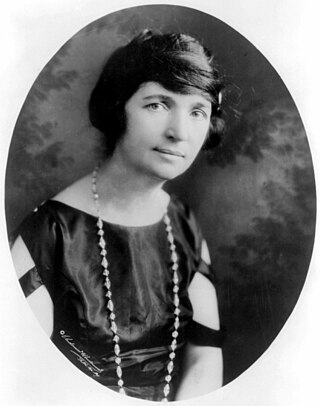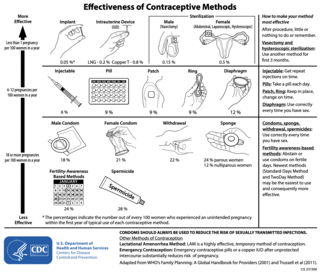Coitus interruptus, also known as withdrawal, pulling out or the pull-out method, is a method of birth control in which a man, during sexual intercourse, withdraws his penis from a woman's vagina prior to ejaculation and then directs his ejaculate (semen) away from the vagina in an effort to avoid insemination.

Margaret Higgins Sanger, also known as Margaret Sanger Slee, was an American birth control activist, sex educator, writer, and nurse. Sanger popularized the term "birth control", opened the first birth control clinic in the United States, and established organizations that evolved into the Planned Parenthood Federation of America.

The Comstock laws are a set of federal acts passed by the United States Congress under the Grant administration along with related state laws. The "parent" act was passed on March 3, 1873, as the Act for the Suppression of Trade in, and Circulation of, Obscene Literature and Articles of Immoral Use. This Act criminalized any use of the U.S. Postal Service to send any of the following items: obscenity, contraceptives, abortifacients, sex toys, personal letters with any sexual content or information, or any information regarding the above items.

The diaphragm is a barrier method of birth control. It is moderately effective, with a one-year failure rate of around 12% with typical use. It is placed over the cervix with spermicide before sex and left in place for at least six hours after sex. Fitting by a healthcare provider is generally required.

The cervical cap is a form of barrier contraception. A cervical cap fits over the cervix and blocks sperm from entering the uterus through the external orifice of the uterus, called the os.
A pessary is a prosthetic device inserted into the vagina for structural and pharmaceutical purposes. It is most commonly used to treat stress urinary incontinence to stop urinary leakage and to treat pelvic organ prolapse to maintain the location of organs in the pelvic region. It can also be used to administer medications locally in the vagina or as a method of contraception.
Prior to the 20th century, three major branches of Christianity—Catholicism, Eastern Orthodoxy and Protestantism —generally held a critical perspective of birth control. Among Christian denominations today, however, there is a large variety of views regarding birth control that range from the acceptance of birth control to only allowing natural family planning to teaching Quiverfull doctrine, which disallows contraception and holds that Christians should have large families.

United States v. One Package of Japanese Pessaries, 86 F.2d 737, was an in rem United States Court of Appeals case in the Second Circuit involving birth control.

Controversy over the beginning of pregnancy occurs in different contexts, particularly as it is discussed within the debate of abortion in the United States. Because an abortion is defined as ending an established pregnancy, rather than as destroying a fertilized egg, depending on when pregnancy is considered to begin, some methods of birth control as well as some methods of infertility treatment might be classified as causing abortions.

There are many methods of birth control that vary in requirements, side effects, and effectiveness. As the technology, education, and awareness about contraception has evolved, new contraception methods have been theorized and put in application. Although no method of birth control is ideal for every user, some methods remain more effective, affordable or intrusive than others. Outlined here are the different types of barrier methods, hormonal methods, various methods including spermicides, emergency contraceptives, and surgical methods and a comparison between them.
The history of condoms goes back at least several centuries, and perhaps beyond. For most of their history, condoms have been used both as a method of birth control, and as a protective measure against venereal diseases such as syphilis, gonorrhea, chlamydia, hepatitis B and more recently HIV/AIDS. Condoms have been made from a variety of materials; prior to the 19th century, chemically treated linen and animal tissue are the best documented varieties. Rubber condoms gained popularity in the mid-19th century, and in the early 20th century major advances were made in manufacturing techniques. Prior to the introduction of the combined oral contraceptive pill, condoms were the most popular birth control method in the Western world. In the second half of the 20th century, the low cost of condoms contributed to their importance in family planning programs throughout the developing world. Condoms have also become increasingly important in efforts to fight the AIDS pandemic.

Birth control, also known as contraception, anticonception, and fertility control, is the use of methods or devices to prevent unintended pregnancy. Birth control has been used since ancient times, but effective and safe methods of birth control only became available in the 20th century. Planning, making available, and using human birth control is called family planning. Some cultures limit or discourage access to birth control because they consider it to be morally, religiously, or politically undesirable.
Medical Common Sense: Applied to the Causes, Prevention and Cure of Chronic Diseases and Unhappiness in Marriage was an 1858 work authored and published by Edward Bliss Foote. The work sold well and an expanded version, Plain Home Talk, Embracing Medical Common Sense, sold 500,000 copies. This expanded version would include over 500 pages of new content and whereas the initial work was written in two parts, Plain Home Talk contained four parts and put a large emphasis on marriage and sexual health and ethics topics.

The birth control movement in the United States was a social reform campaign beginning in 1914 that aimed to increase the availability of contraception in the U.S. through education and legalization. The movement began in 1914 when a group of political radicals in New York City, led by Emma Goldman, Mary Dennett, and Margaret Sanger, became concerned about the hardships that childbirth and self-induced abortions brought to low-income women. Since contraception was considered to be obscene at the time, the activists targeted the Comstock laws, which prohibited distribution of any "obscene, lewd, and/or lascivious" materials through the mail. Hoping to provoke a favorable legal decision, Sanger deliberately broke the law by distributing The Woman Rebel, a newsletter containing a discussion of contraception. In 1916, Sanger opened the first birth control clinic in the United States, but the clinic was immediately shut down by police, and Sanger was sentenced to 30 days in jail.

Birth control in the United States is available in many forms. Some of the forms available at drugstores and some retail stores are male condoms, female condoms, sponges, spermicides, and over-the-counter emergency contraception. Forms available at pharmacies with a doctor's prescription or at doctor's offices are oral contraceptive pills, patches, vaginal rings, diaphragms, shots/injections, cervical caps, implantable rods, and intrauterine devices (IUDs). Sterilization procedures, including tubal ligations and vasectomies, are also performed.
Holland–Rantos was a company founded in the United States 1925 by birth control advocates that manufactured high-quality contraceptives. Its primary product was the diaphragm, which was Margaret Sanger's recommended method of contraception. The company also sold a lubricating jelly under the name "vaginal jelly", based on a formula imported from Germany. In the 1940s, Holland–Rantos was bought by Young's Rubber Co., which manufactures the Trojan Condom. Around 2000, a new company HR Pharmaceuticals was founded, which sells lubricating jelly under the name "HR Jelly".
The history of birth control, also known as contraception and fertility control, refers to the methods or devices that have been historically used to prevent pregnancy. Planning and provision of birth control is called family planning. In some times and cultures, abortion had none of the stigma which it has today, making birth control less important.
Reproductive coercion is a collection of behaviors that interfere with decision-making related to reproductive health. These behaviors are meant to maintain power and control related to reproductive health by a current, former, or hopeful intimate or romantic partner, but they can also be perpetrated by parents or in-laws. Coercive behaviors infringe on individuals' reproductive rights and reduce their reproductive autonomy.
Family Limitation is a pamphlet written by American family planning activist, eugenicist, educator, writer, and nurse Margaret Sanger that was published in 1914. It was one of the first guides to birth control published in the United States. The 16-page pamphlet details information on, and ingredients for, various contraceptive methods and included illustrations and instructions for use. After the pamphlet was released, Sanger was forced to flee the United States to Britain to avoid prosecution under federal anti-obscenity laws, the Comstock Act, which prohibited disseminating information about contraception.
There are many types of contraceptive methods available in France. All contraceptives are obtained by medical prescription after a visit to the family planning, a gynecologist or a midwife. With the exception of emergency contraception that does not require a prescription and can be obtained directly in a pharmacy.











